Songlines in Plymouth — immersed in Aboriginal dreaming
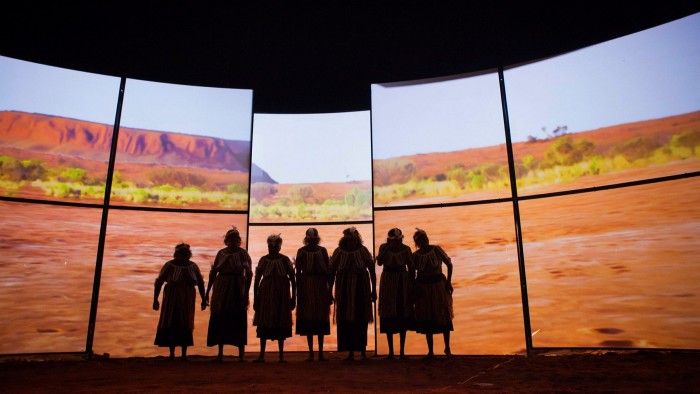
Roula Khalaf, Editor of the FT, selects her favourite stories in this weekly newsletter.
A black dome has appeared outside Plymouth’s recently revamped cultural complex, The Box. Visitors can step inside, settle back and tune in to the immersive spectacle projected on the ceiling above: the first film of Walinynga, a cave in central Australia that is home to some of the world’s oldest rock art. Then it’s up into the night sky for a time-lapsed transit of the Orion constellation and the Pleiades star clusters, before returning to earth in the company of seven quirky life-sized woven figures.
In Songlines: Tracking the Seven Sisters, contemporary art meets history, science and cosmology to tell a foundation story of the indigenous people of Australia, one of the world’s oldest continuing societies. And it uses the very latest technology to do so, the cinematic experience in the purpose-built dome underlining the fact that in the indigenous world you learn with your whole body.
It’s intriguing that the exhibition, originally mounted at the National Museum of Australia (NMA) in Canberra in 2017, should pitch up in Plymouth, the British port from which British explorer James Cook set sail in 1768 in search, among other things, of the fabled Terra Australis. “The empire strikes back!” quips the show’s indigenous Australian curator Margo Neale.
Featuring the work of more than 100 Aboriginal artists, the exhibition is part of the UK/Australia Season, a programme of cultural exchange by the British Council and Australia’s Department of Foreign Affairs explored through theatre, talks, music and more in both countries.
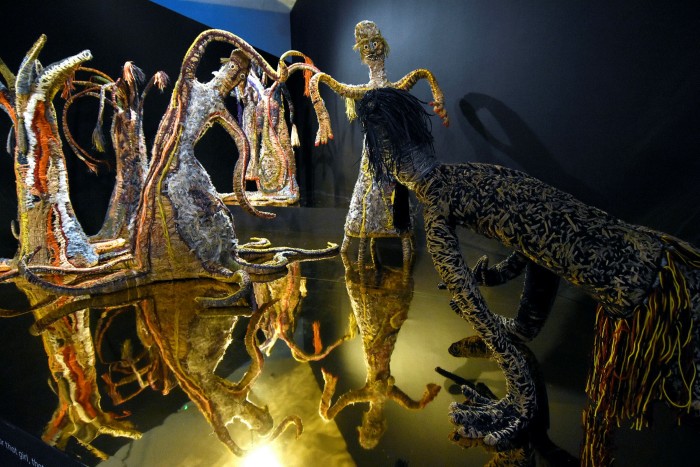
The Seven Sisters and their exploits are a key element of the Tjukurpa or dreaming — stories, knowledge and spiritual beliefs that bind indigenous Australians to the environment and their ancestry. Like most epic sagas, it involves high drama and magic, but also earthy comedy: the sisters are on the run, pursued by a lustful sorcerer, who transforms himself into luscious fruit or a shady tree to trick and trap them. It’s also a tale of female solidarity, and the sisters are wise to his ruses; they mock and taunt him, flying up into the air, flashing their genitals at him.
They protect each other, and the eldest sister, the one he wants, teaches the younger ones how to survive. Trouble is, whatever the intentions of this shape-shifting pursuer, known variously as Yurla or Wati Nyiru, his penis has a mind of its own. It takes off, reappearing at one point in a waterhole as a carpet snake: “Good tucker!” the women cry, and they later cook and eat it, to their cost. Time and again the women outwit Yurla, but they can never quite shake him off. The story ends with them flying off into the night sky to take their place as the Pleiades.
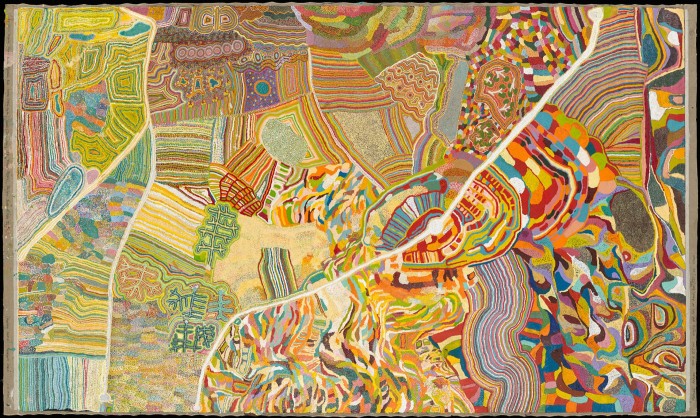
Tales of the Seven Sisters can be found right across Australia, but this exhibition focuses on “songlines” in the west, the routes where the women criss-crossed the desert, leaving traces of themselves in the landscape. This is the territory of the Martu, Ngaanyatjarra and Anangu, Pitjantjatjara and Yankunytjatjara (APY) people, where in 2010 the elders had grown worried that their grandchildren were too wrapped up in social media to bother with foundation stories. Ancient knowledge, they felt, was in danger of dying out, so they approached the Australian National University and the NMA: “You mob gotta help us,” said Anangu elder David Miller. “Those songlines, they been all broken up . . . you can help us put them back together again.”
A multi-faceted project got under way, with the Canberra iteration of this engrossing exhibition a primary outcome. In response to NMA commissions, indigenous artists (many of them now in their seventies and eighties) created fresh works that tell the sisters’ tale from different angles and in different forms.
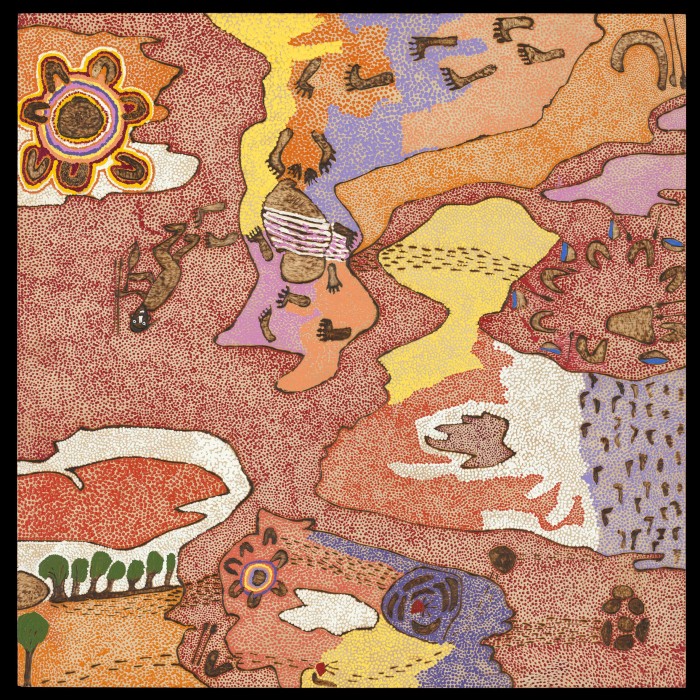
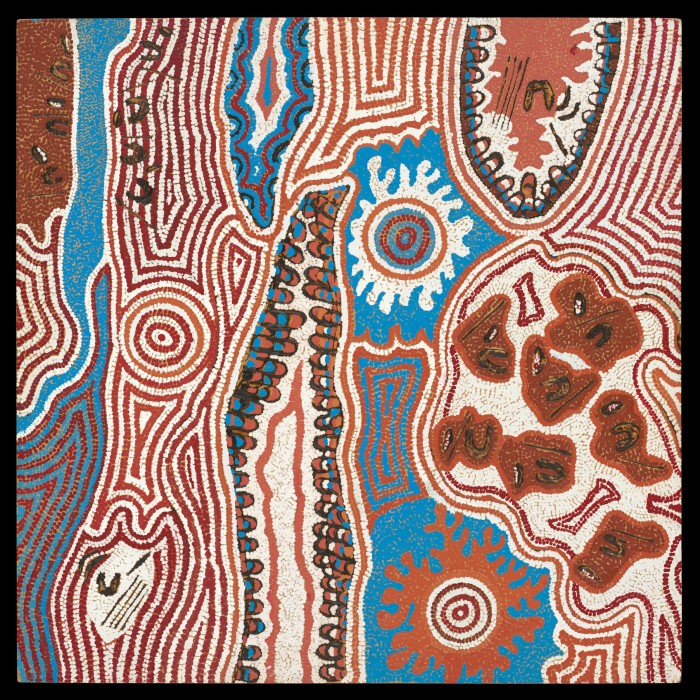
The Martu are among the last Aboriginal people to live a traditional way of life in the desert, where they are today recognised as experts in using fire to maintain plant and animal diversity. Though many moved to missions in the 1960s, in the 1980s they returned to communities in their traditional lands (including Parnngurr, whose painting shed is the source of a number of works in this show). In the show, a short film Minyipuru Parnngurr Rock Hole (2016) intersperses mesmerising footage of the desert with four Martu women revisiting sacred sites and pointing out, for example, a water hole where Yurla emerges or the rock clusters that evoke the sisters asleep.
Seven ceramic pots, accompanied by beautifully illustrated notebooks, speak of the sisters using their knowledge of culture and ceremony to escape Yurla — the water at the Aniri claypan is depicted, plus five bush foods: honey ants, witchetty grubs, quandong, fig and bush tomato. Alison Milyika Carroll, an Aboriginal ceramic artist at Ernabella Arts, Australia’s oldest indigenous arts centre, worried about loss of knowledge when she asked her granddaughter to fetch a certain twig and the girl had no idea what the word meant. “With the knowledge of the name [for example] of a bird, you also learn where you might see it, what it eats, what its tracks look like,” she says. “The name is a key to knowledge.”
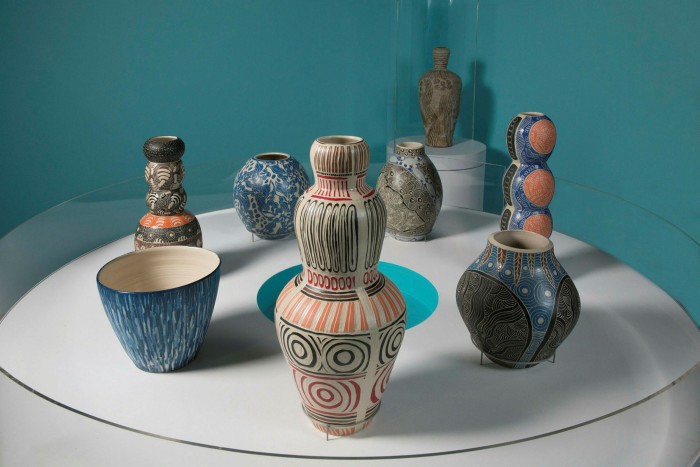
The woven sculptures of the sisters are also a delight. We see them in the film, then installed across the ceiling. Another group sprouts roots and branches: they are part women, part tree. These are the work of the Tjanpi Desert Weavers, who come from more than 20 communities. Tjanpi is the Pitjantjatjara word for a type of spinifex grass, which the women added to their weaving skills in the 1990s. In 2005, a group of them were awarded the Telstra National Aboriginal and Torres Strait Islander Art Award for a life-size woven Toyota.
The show also features large numbers of dot paintings, which for some people will conjure memories of the “discovery” of indigenous Australian art by the west in the 1970s and the late critic Robert Hughes’s description of it as “the last great art movement of the 20th century”. But the Songlines paintings are very much 21st century — inspired by both the Seven Sisters stories and the landscape and made, often collaboratively, on trips out into the desert.
Among the most impressive is “Yarrkalpa — Hunting Ground, Parnngurr Area” (2013), a three-metre by five-metre acrylic work made by Martu artists. In this huge, richly detailed painting, the sisters’ tales are interwoven with subtly depicted knowledge of the seasons, of water sources and plants and animals, from where to dig for wild onions to the time and place to hunt parnajarlpa, the goanna that is a staple bush food.
The 2020 First Nations-led Sydney Biennale showcased the work of mainly young, mainly urban Aboriginal artists. Though the pandemic forced it online for a time, it was seen as a game changer, a festival that widened audience perceptions of what indigenous Australian art could be. Songlines, which will tour to Paris and Berlin, is the other side of the coin, highlighting the inspiring mix of innovation and tradition, the enthusiasm for experiment and the openness to new ideas on the part of (much older) artists who live in or are closer to country.
To February 27, theboxplymouth.com
Comments